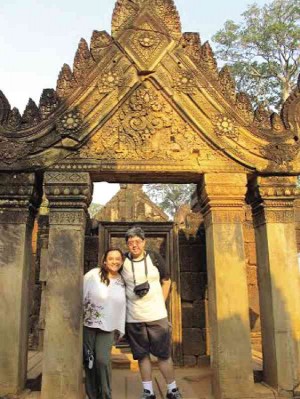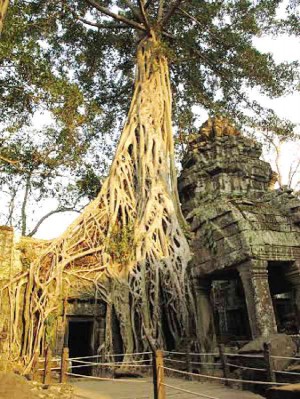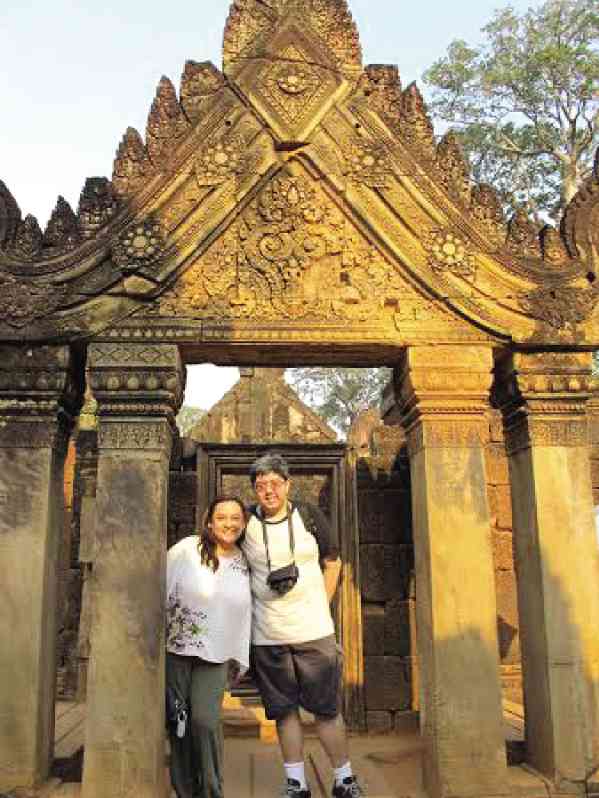
Cambodia was never on my list of must-see places.
It has always seemed underdeveloped, with nothing much going on except for the temples. But Siem Reap was on top of my girlfriend Margaret’s bucket list. The temple ruins and giant trees had been calling her to visit for years.
So, this year, we decided to go. We set a comfortable and affordable budget. We gathered our things, snatched up a good deal on a Cebu Pacific flight, scoured travel websites for recommended activities, settled our accommodations, and booked our tour guides and drivers in advance.
Upon arrival, the first thing that strikes you is how much character the Siem Reap International Airport has for its small size. But as you enter, you are greeted by a clean, brightly lit building with statues of personalities from Cambodian religion and history.
A tuk-tuk, Cambodia’s popular mode of transport, a cross between a tricycle and a jeepney, is waiting to pick us up and bring us to our hostel.
The ride itself is an experience. Not very spacious if you have bulky luggage, but it gets you where you need to go. And surprisingly, even without air-conditioning, the ride is generally cool, because you get a lot of wind in your face.
Siem Reap is a world away. While you do get WiFi and HBO, the whole place seems unhurried. There’s no rush for anything. It can be comfortable but not fully cosmopolitan.
We are fortunate enough to find an inexpensive but comfortable place to stay, the Siem Reap Hostel. It is clean, has a friendly staff, and exudes a relaxed vibe.
If you opt for a private room instead of the dorms, you get a free breakfast of fruits, pancakes, cereal and bread. Plus, to my surprise, one free load of laundry. But, most importantly, this particular hostel has an indoor pool to help keep the heat at bay.
Affordable to pricey
Pub Street, Siem Reap’s row of bars and restaurants, is a mere five-minute walk from the hostel. Bland and nondescript during the day, it comes alive at night. People from all over, locals and foreigners, descend for a good meal and some drinks.
Food can range from affordable to pricey, according to your tastes. A typical dish can go from $3 to $4.50 for one of the medium-range places, and $6 to $12 on average for the higher-end restaurants. Strangely enough, beer, at around $1, is cheaper than Coke, which averages around $1.50 to $2.
Khmer dishes have many similarities to other cuisines in the region in terms of flavors and presentation. It has some coconut and curry dishes, but few are debilitatingly spicy.
I enjoyed the chicken and lemongrass in coconut sauce, while Margaret savors the beef lok-lak and the ever-present pepper sauce.
A stone’s throw away from Pub Street is Siem Reap Night Market, with its many stalls selling Cambodian silk clothing, trinkets, souvenirs and sundries.
The next day we start early, getting picked up at 8:30 by our tour guide, Mr. Chet, for our trip to the Thousand Lingas.
It is basically a riverbed that feeds into a small waterfall. In this bed are carved numerous lingas, which are symbols in Hinduism. The practice, we are told, was that monks would pour water on a linga, which would then drain out into a receptacle.
Having touched the linga, the water would then be blessed, and people in the olden days would use the water to drink and wash. So the king had the bright idea of carving lingas into the riverbed, thereby making all the water that came from the falls holy and medicinal water.
The trek to the waterfall is a kilometer and a half, on a slight but almost constant incline. I’ve seen reviews online where people say, “Skip a guide, just get a book.” Maybe for the temples, but for this, definitely get a guide who knows the area and who can assist you going up and down the many slippery and rocky portions of the path.
The waterfall itself is small during this month, but the waters are cool and refreshing. People are allowed to play in the falls, but we opt to just get our feet wet.

The second day we stay in town, deciding to visit Angkor Wat National Museum for the afternoon. It is very easy to be “templed out” in Siem Reap. If you go from one temple to the next, it all becomes a blur. Some say you can see majority of the big temples in a day. We don’t recommend that. Take the three-day pass instead of the one-day one to appreciate the temples better, and to save yourself from heatstroke.
Going to the museum is a good idea in hindsight, because we are able to better understand what was going on at the temples.
New understanding
With rested legs and a new understanding of Shiva, Brahma, Vishnu and Naga, we head for Angkor the next morning. The plan is to catch the sunrise over Angkor Wat, so we leave our hostel at 4 a.m. with our tuk-tuk driver, Da Mao.
Da Mao is highly recommended on the Virtual Tourist website, which is why we decide to contract his services. Even more interesting is that he had so impressed a couple from Mindanao, they bought him his own tuk-tuk.
His dark-wood ride proudly declares his gratitude on the back, and Da himself goes around wearing a Philippines cap.
If ever you find yourself going to Siem Reap, get him to drive you around. (Find him on Facebook: Angkor Tours Driver.)
After driving us to the gate of Angkor Wat, Da gives us valuable tips on where to best position ourselves for the sunrise. Sadly, it is an overcast morning and the hoped-for orange-and-purple sky turns into a bluish haze instead.
The next temple we visit is Bayon, known for the many faces carved into stone, looking down at all who pass by. You can’t help but ask, why are they smiling?
Like most temples, Bayon is oriented toward the east, with gates corresponding to the four cardinal directions. It sits right at the center of the Angkor Thom complex, and all roads from the city gates lead directly to Bayon.
Bayon is referred to as a guy’s temple. The favorite of the girls then would be Banteay Srei, which is made of pink sandstone and has more intricate stonework.
That afternoon, we return to Angkor Wat for the sunset. By this time the haze has cleared, and even from afar you can make out the details of the carvings on the walls.
Unfortunately, tourists come in droves. It’s a hard lesson, but we learn that you can never ever get a clean shot of the facade of Angkor, unless you take your time and erase the pesky intruders from the frame on your gadget of choice.
But with the sheer size of Angkor, there are, thankfully, other places, nooks and crannies where one can get in a few photos of just the ruins, with no fellow sightseers to ruin them.
As imposing as it can be from afar, Angkor is amazing up close. Many of the carvings are gone now, and some of the stones are restored and no longer original, but you can still see many from centuries ago.

Angkor Wat is unique among the ancient structures of Cambodia in that it is oriented toward the west, a direction associated with death—making some scholars conclude that it was a mausoleum of some sort, and not simply a temple to the gods.
It also casts the main temple in a golden light at sunset, which gives it a regal glow.
The next day, our last in Siem Reap, we make one last stop on our list. This one is nonnegotiable—Ta Prohm, the temple reclaimed by the jungle, the reason for our entire trip.
When we arrive it was slightly past 2 p.m. There are many people, but not nearly as many as in Angkor Wat.
Ta Prohm was made famous by the film “Tomb Raider” starring Angelina Jolie. Its other biggest claim to fame are its giant trees.
Forest canopy
The forest canopy is very much welcome, as it keeps out the sun’s heat. But thankfully, it also lets in enough dappled sunlight to play on the trees and the structures. Pretty soon it is the golden hour, that time of day when the sunlight has a golden tinge, making everything it touches radiant and almost otherworldly.
Looking at the temple, I remember the Percy Bysshe Shelley poem, “Ozymandias,” about a once great king who boasted of his grand achievements, only to have them all buried by the sands of time, his name all but forgotten. I look up the poem again, and find there is another version by Horace Smith, Shelley’s friend and contemporary.
Some lines that stand out:
He meets some fragment huge, and starts to guess
What powerful but unrecorded race
Once dwelt in that annihilated place.
It was like mother nature saying you’ve had your fun, now it’s my turn again.
Walking through the ruins of an ancient city, resting under the shade of a centuries-old tree—these are life experiences that I will keep with me.
I can totally see why Margaret had the temples on her bucket list. We’ve barely been back from Siem Reap, and she’s already clamoring to go back. And knowing her, we will.









































